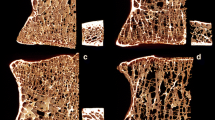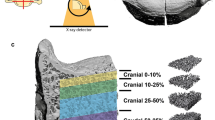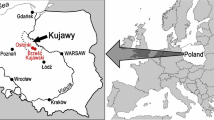Summary
The vertebral bodies consist of two main structures, trabecular and cortical bone. The histological changes within the spine, especially in cortical bone, leading to osteoporotic fractures remain, however, poorly understood. Therefore, the complete front column of the spine was removed in 26 autopsy cases without skeletal diseases and in 11 cases with proven osteoporosis. A sagittal segment prepared through the center of all vertebral bodies was undecalcified embedded in plastic, ground to a 1-mm-thick block and stained using a modification of the von Kossa method. The analysis included measurement of the mean cortical thickness of both ventral and dorsal shell (from C3 to L5). The qualitative investigation of the structure of the cortical ring completed the analysis. The skeletally intact specimens had high cortical thickness values in the cervical spine (285 ± 22 μm), a decrease in the thoracic spine (244 ± 14 μm) and an increase in the lumbar spine (290 ± 15 μm). The mean thickness of the ventral shell is in general higher than the thickness of the dorsal shell. The cortical thickness of the spine showed no gender-specific differences (P = n.s.). There was a slight decrease in cortical thickness with age; however, this decrease and the correlation of cortical thickness to age was only significant below vertebral body T8 (r = 0.225 to 0.574; Pr < 0.05 to Pr < 0.005). Most interestingly, osteoporosis is characterized by a significant decrease in cortical thickness throughout the whole spine. This decrease in cortical thickness was more marked in the dorsal shell (P < 0.05) than in the ventral shell (ventral from C3 to T6 (P < 0.05) below T6 (P = n.s.). We therefore conclude that in osteoporosis, biomechanical competence is affected by both trabecular bone loss and decrease of cortical thickness. This suggests that, in addition to trabecular bone measurements, the cortical thickness is of special interest for diagnostic radiological examinations (CT) to yield clues about the risk of vertebral fractures.
Zielsetzung: Wirbelkörper bestehen aus den beiden Hauptkomponenten Spongiosa und Kortikalis. Trotz kontroverser Meinungen zur biomechanischen Bedeutung dieser Strukturen für die Stabilität der Knochen liegen über die Dicke der Kortikalis in der Literatur allerdings nur wenige Angaben vor.
Material und Methode: Die Studie untersuchte die Kortikalisdicke der Wirbelkörper der kompletten Wirbelsäule von 26 Autopsiefällen ohne Skeletterkrankung und 11 Fällen mit Osteoporose. An 1 mm dicken und speziell präparierten oberflächengefärbten Blockpräparaten wurde die mittlere ventrale und dorsale Kortikalisdicke (Ct. Th.) von C3 bis L5 durch eine direkte Messung in der Sagittalebene bestimmt.
Ergebnisse: Die Dicke der Kortikalis beträgt in der Halswirbelsäule 285 ± 22 μm, in der Brustwirbelsäule 244 ± 14 μm und in der Lendenwirbelsäule 290 ± 15 μm, bei insgesamt niedrigeren Werten der dorsalen Kortikalis. Sowohl für die ventrale als auch für die dorsale Kortikalis fanden sich keine signifikanten Geschlechtsunterschiede. Es war eine geringe Abnahme der Kortikalis über das Alter zu verzeichnen, diese Veränderungen zeigten jedoch nur unterhalb des Wirbelkörpers T8 eine signifikante Korrelation (r = 0,225 bis 0,574, p r < 0,05). Auffällig war eine deutliche Reduktion der Kortikalisdicke bei den Fällen mit Osteoporose. Diese war im Bereich der dorsalen Kortikalis stärker ausgeprägt (p < 0,05) als im Bereich der ventralen (C3 bis T6 p < 0,05 unterhalb von T6 p = n.s.).
Diskussion: Bei Osteoporose kommt es neben dem Verlust an Spongiosa auch zu einer Reduktion der Kortikalisdicke, wobei die biomechanische Bedeutung dieser beiden Strukturen kontrovers diskutiert wird. Es wäre deswegen zu prüfen, inwieweit der radiologischen Messung der Kortikalisdicke (z. B. mittels CT) neben der Bestimmung der spongiösen Knochenmasse eine zusätzliche Bedeutung zur Erfassung der Frakturschwelle von Wirbelkörpern bei Osteoporose zukommt.
Similar content being viewed by others

Author information
Authors and Affiliations
Rights and permissions
About this article
Cite this article
Ritzel, H., Amling, M., Hahn, M. et al. Quantitative morphology of the vertebral body cortex. Radiologe 38, 315–320 (1998). https://doi.org/10.1007/s001170050360
Issue Date:
DOI: https://doi.org/10.1007/s001170050360



